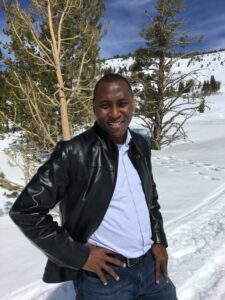About
I grew up in a Nigerian family where my father was an agricultural expert for a federal government institute that breeds new cocoa varieties, and my mother was a biology teacher and elementary school administrator. I lived most of my childhood inside the government staff complex built within a tropical forest; thus, I go to bed to the barking of wild dogs, wake up to birds chirping in the trees, and seeing packs of monkeys jumping in the trees in broad daylight. This childhood experience was my foundation and entry into the world of biodiversity conservation. I obtained an undergraduate degree in Botany after completing a research thesis on a common garden experiment of provenances of a leguminous food crop. My Master’s research investigated phenotypical differences in the anatomical, phytochemical, and leaf and pollen morphology of a widely distributed plant in Nigeria, resulting in the publication of four papers. During this period, I started working as a Senior Scientific Officer at the National Center for Genetic Resources and Biotechnology (NACGRAB), Ibadan, Nigeria, which has a national mandate for conserving genetic diversity of Nigeria’s flora and fauna. I was responsible for the management of the ex-situ field gene bank and the herbarium; for that reason, I traveled across the country studying and collecting plants and their spatial distribution. This work experience geared my interest to biogeography to understand the ecological and evolutionary underpinnings of the spatial distribution of plants.
I moved to the United States to undertake a PhD at the University of Nevada, Reno. My PhD project focused on increasing the scientific understanding and generating new data that will inform the conservation of Ivesia webberi, a lesser known, range-restricted, and U.S. federally-threatened forb, native to the western Great Basin Desert. My PhD dissertation comprised five chapters that integrated ecological niche modeling, landscape genetics, genome size evolution, and the regeneration niche of the focal species and other taxa in the genus. The niche modeling led to the discovery of several new locations of this species and expanded the known range.
My passion for biogeography was reignited when I met Dr. Brent Mishler at the Northern California Botanist meeting, where he presented on the spatial phylogenetics of the California vascular flora. With his encouragement and support, I applied and received postdoctoral research funding through the David H Smith Conservation Research Fellowship. My postdoctoral research focus on learning spatial phylogenetics, and applying the various alpha and beta metrics and methods to the U.S. vascular flora based on various facets of phylodiversity.
Research Interests
Plant biogeography, ecological niche modeling, spatial phylogenetics, community ecology and phylogenetics, biological invasions, science-policy interface.
ResearchGate link: https://www.researchgate.net/profile/Israel-Borokini
Google scholar: https://scholar.google.com/citations?user=zvXrKpUAAAAJ&hl=en
Personal website: https://tbisrael.wixsite.com/website
C.V.
My C.V. can be downloaded here.
Publications
I have published two books, edited two scientific conference proceedings, authored 60 original and review papers, listed two IUCN red list of threatened species, gave 35 presentations at scientific meetings as well as eight invited talks, and one citable data product.
Borokini IT, Klingler KB, and Peacock MM (2021). Life in the desert: The impact of geographic and environmental gradients on genetic diversity and population structure of Ivesia webberi. Ecology and Evolution 11(23): 17537-17556. https://doi.org/10.1002/ece3.8389
Mwampamba TH, Egoh BN, Borokini IT, and Njabo K (2021). Challenges encountered when doing research back home: Perspectives from African conservation scientists in the diaspora. Conservation Science and Practice e564. https://doi.org/10.1111/csp2.564
McAlvay AC, Armstrong CG, Baker J, Black L, Bosco ES, Hanazaki N, Joseph L, Martínez-Cruz ET, Nesbitt M, Palmer MA, de Almeida WCP, Anderson J, Asfaw Z, Borokini IT, Cano-Contreras EJ, Hoyte S, Hudson M, Ladio AH, Odonne G, Peter S, Rashford J, Wall J, Wolverton S and Vandebroek I (2021). Ethnobiology Phase VI: Decolonizing institutions, projects, and scholarship. Journal of Ethnobiology 41(2): 170–191. https://doi.org/10.2993/0278-0771-41.2.170
Borokini TI, Weisberg PJ, and Peacock MM (2021). Quantifying the relationship between soil seed bank and plant community assemblage in sites harboring the threatened Ivesia webberi in the western Great Basin Desert. Applied Vegetation Science 24(1): e12547. https://doi.org/10.1111/avsc.12547
Grimaldi IM, Leke WN, Borokini TI, Wanjama D and van Andel T (2018). From landraces to modern cultivars: field observations on taro Colocasia esculenta (L.) Schott in sub-Saharan Africa. Genetic Resources and Crop Evolution 65: 1809–1828. https://doi.org/10.1007/s10722-018-0651-4
Photo Gallery
